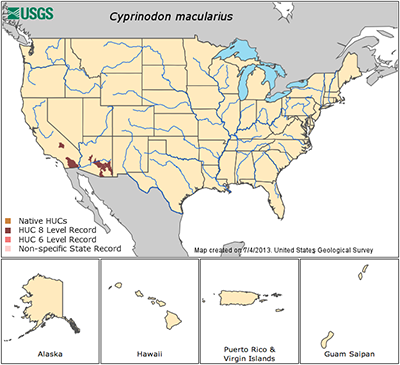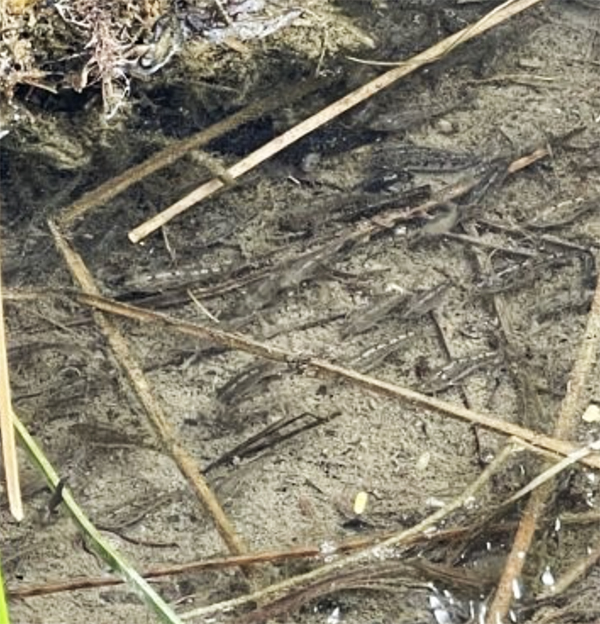Desert and Sonoyta Pupfish

About
The desert pupfish may be small (up to 1.5 inches), but they pack a personality! They are named after puppies due to their playful behavior. Males and females are easy to tell apart. The females are brownish olive, and males are shimmering blue-green. When they swim and flash in the light, the males look brilliantly blue.
Adaptations
These species are remarkably adaptable to sudden changes in temperature and salinity (the amount of salt in the water). They have been known to survive in fresh water (like streams and lakes), as well as water twice as salty as the ocean! They can also survive in water temperatures over 100°F (38°C) or below 50°F (10°C).
Challenges
Water resources in the Sonoran Desert are important for both wildlife and people. About 85% of wildlife species need surface water or riparian habitat at some point in their life. Sonoyta pupfish (C. eremus) are endangered due to habitat destruction. Also, non-native fishes will eat and displace native pupfish. As habitat loss and introduced species take the place of native fish populations on both sides of the border, it is very important to save wild spaces!

Habitat and Range
These are desert oasis fish — found in springs, marshes, lakes, and creek pools. Pupfish prefer areas with sand at the bottom. People and communities on both sides of the U.S.-Mexico border are recognizing the value of healthy riparian ecosystems and are working together to save and help fix them.
Originally, desert pupfish (Cyprinodon macularius) and Sonoyta pupfish (Cyprinodon eremus) were thought to be a single species found across the Lower Colorado River in Arizona, California, and northern Mexico. Now they are known to be two separate species, both found in a much smaller area than they used to be. The Sonoyta pupfish was historically found all throughout the Rio Sonoyta and Organ Pipe’s Quitobaquito. As human development has changed the Río Sonoyta, it no longer reaches the Gulf of California and has dried up through most of the areas except towards the U.S border. The Desert pupfish had a historically larger range as well — all populations were below 1,650 meters in elevation, but could be found in the Gila River Basin, the southern tip of the lower Colorado River, Baja California Norte, California, and Sonora. In California it was found specifically in the Salton Sea and Laguna Salada basins. Currently, they are only found in the wild in the Salton Sea and its tributary streams, Cerro Prieto and Laguna Salada in Baja California Norte, and Cerro Prieto in Sonora.
By USGS — https://nas.er.usgs.gov/queries/FactSheet.aspx?speciesID=654, Public Domain, https://commons.wikimedia.org/w/index.php?curid=29173743

Family Life
Breeding occurs mainly in the spring and the summer. Breeding males are fiercely territorial, defending their turf from other males. Females that are ready to spawn (release eggs) will enter the male’s territory. After spawning, the male guards the nest. Sometimes another male may sneak into his territory while the dominant male is busy chasing away other fish. The subordinate male may fertilize the female’s eggs and then quickly swim to a safe place. If that happens, the dominant male can end up protecting eggs fertilized by another male!
Since pupfish eat both plants and animals at some point in their lives, they are omnivorous. They’ll eat small aquatic animals, such as invertebrates, and plant material or detritus, like algae.
Glossary
- Detritus:
- waste or debris; often the result of decomposition
- Displace:
- to forcibly replace or cause an organism to disappear from an area
- Introduced species:
- an organism that has been brought (on accident or on purpose) to an area where it is not native
Fun Facts
- Pupfish can live up to 3 years.
- Their natural predators are herons, kingfishers, and common grackles.
- The Sonoyta Pupfish is also called the Quitobaquito pupfish.
- Cobach Sonora in Sonoyta hosts one of the pupfish conservation ponds on their campus and even has a pupfish as their school mascot!
Conservation
The Sonoyta pupfish (Cyprinodon eremus) is now found only in a few ponds in southern Arizona and northern Sonora and is an endangered species in both the U.S. and Mexico! Most of the conservation work has been to establish assurance populations to make sure that species will survive in case (a) we are unable to restore their natural habitats or (b) something catastrophic happens to the remaining natural fish populations. For this purpose, human-made ponds are maintained on both sides of the U.S.-Mexico border with the help of a variety of agencies and partners (for example, CEDO Intercultural in Puerto Peñasco). The ponds are also used to ignite an interest in the public and get them excited about conserving these little fish!
At The Museum
The Museum took care of a display population of pupfish (C. macularius & C. eremus) from 1981 to 2018. When we first got them, they were not yet distinguished as two separate species! We also support pupfish by working with other organizations and helping to design and find space to build ponds. Future plans include getting a breeding population of the endangered Sonoyta pupfish (C. eremus) at the Museum!
Learn more about native fishes in the Riparian Corridor and Warden Aquarium.










